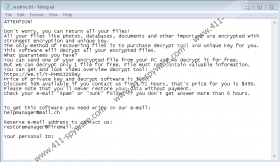Mzlq Ransomware Removal Guide
You must not take your Windows security for granted because threats like Mzlq Ransomware are patiently waiting for their opportunities to slither in and make a huge mess. While this particular infection does not affect how your system works, it does not drop additional threats, and it is unlikely to steal private data, it can corrupt personal files, and this might hurt more, on a personal level, than data theft or malware invasion. When the devious ransomware corrupts your files, it changes their data by encrypting it, which means that you cannot read them. Your documents, family photos, and other personal files are locked, and there might be nothing you can do about it. The attackers behind this malware want you to think that you can buy your way out of this lockdown, but trusting cybercriminals is not a good idea. It goes without saying that you need to delete Mzlq Ransomware, and if you are not sure how to do it, we have a few important removal tips. We might also have tips for the recovery of files. Keep reading.
When Mzlq Ransomware spreads, it is most likely to use email, downloads, and vulnerabilities. The .exe file of this threat can be concealed as a document, as a harmless file, or even an update, and so you could be tricked into executing it yourself. Once inside, this malware drops files to %HOMEDRIVE%, %WINDIR%, and %LOCALAPPDATA% directories. It also adds a Run value to the Windows Registry. To keep itself undetected or unidentified, the infection also disables the Task Manager, so that you could not look for and terminate malicious processes. None of this is news to us because Mzlq Ransomware is yet another threat to come from the STOP Ransomware family, just like Sqpc Ransomware, Jope Ransomware, Mpaj Ransomware, and hundreds of other threats. They all spread the same, work the same, and even have the same demands. In fact, we believe that all of these threats are controlled by the same attackers. That is because the contact information (helpmanager@mail.ch/restoremanager@firemail.cc) presented via the “_readme.txt” file has been seen in the ransom notes of other threats as well.
When Mzlq Ransomware encrypts files and adds the “.mzlq” extension to their names, the victims are locked out of their own files, and that is when the attackers drop the “_readme.txt” file. The message inside this file informs about the encryption, promotes an allegedly effective decryptor, and instructs to pay a ransom of $490. Hopefully, you know by now that contacting cybercriminals is a terrible idea because they could use the connection to you to terrorize you, to demand more money after you pay the initial ransom, and also to scam you in new ways. Of course, if you do not send the attacker a message, you will not be able to pay the ransom, but we do not recommend paying it anyway. The decryptor you are promised will not be sent to you, and you will be stuck in the same spot, just with less money in your wallet. Our hope is that after you remove Mzlq Ransomware, you will be able to replace the corrupted files with backup copies (they could be stored online or on external drives) or you will be able to use the free STOP Decryptor. This tool, however, does not guarantee full recovery.
The guide below has many steps, but you need to perform every single one of them successfully if you want to remove Mzlq Ransomware yourself. If this is the path you choose to follow, we strongly advise scanning your system after you are done with the last step because you want to make sure that no leftovers of the ransomware exist and that no other threats exist either. Unfortunately, even if you are successful, your operating system’s security will not be enhanced, and that is something you need to think about as well. Your system requires comprehensive protection if you want to avoid malware attacks in the future, and so this might be high time you implemented trusted anti-malware software. Not only can it safeguard your entire system but also automatically delete Mzlq Ransomware along with any other threats that might exist without you knowing about them.
How to delete Mzlq Ransomware
- Simultaneously tap Win+R keys to access Run.
- Type regedit into the dialog box and click OK to access the Registry Editor.
- Go to HKEY_CURRENT_USER\Software\Microsoft\Windows\CurrentVersion\Run.
- Right-click the value named SysHelper and then click Delete.
- Simultaneously tap Win+E keys to access File Explorer.
- Enter %LOCALAPPDATA% into the field at the top. Windows XP users need to enter %USERPROFILE%\Local Settings\Application Data\ instead.
- Right-click the file named script.ps1 and click Delete.
- Right-click and Delete the folder with a random name that contains the {unknown name}.exe file.
- Right-click and Delete another folder with a random name that contains the updatewin.exe and updatewin2.exe files.
- Enter %WINDIR%\System32\Tasks\ into the field at the top.
- Right-click the task named Time Trigger Task and click Delete.
- Enter %HOMEDRIVE% into the field at the top.
- Right-click the ransom note file named _readme.txt and click Delete.
- Exit all utilities and then Empty Recycle Bin.
- Run a full system scan using a legitimate malware scanner.
Mzlq Ransomware Screenshots:


